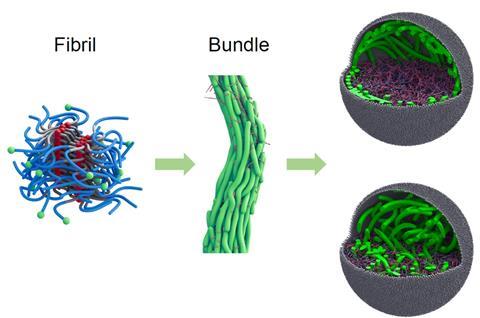
Using diacetylene-based building blocks, researchers in Eindhoven have succeeded in creating an artificial cytoskeleton that closely mimics the mechanical properties of its living counterpart, reports Nature Chemistry.
If you want to build a functioning, lifelike synthetic cell, a cytoskeleton is an indispensable component. People have been working on this for a while, including on the basis of DNA, but Sebastian Novosedlik, Jan van Hest and colleagues at Eindhoven University of Technology took a different approach. ‘We took a more polymer-based approach’, explains Professor of Bioorganic Chemistry Jan van Hest. In collaboration with the company SyMO-Chem and the Max Planck Institute in Erlangen, they succeeded in building a polymer skeleton with various natural functions.
Surprised
‘Our cell system consists of amylose polymers and polymer membranes, and to keep the whole thing consistent, we looked at polymeric fibres’, continues Van Hest. ‘Our first approach was to use small molecular systems that self-assemble and then bundle into larger filaments. This was immediately very successful.’ When the resulting microfibres came into contact with positively charged polymers, a beautiful network was formed. Compared to DNA cytoskeletons, the use of polymer fibres gives more control and more possibilities to functionalise the system, according to Van Hest.
For the base of our synthetic cell, we use amylose coacervates, a kind of liquid droplet with a mixture of oppositely charged polymers, which leads to phase separation.’ Although their density is similar to that of a real cell, they are so different that they also have different properties. The team was therefore very surprised that they were able to mimic the mechanical properties of a living cell so effectively.
High-throughput system
Using Jochen Guck’s confocal microscopes at the MPI Erlangen, they were able to compare the properties of the synthetic and living cells in a high-throughput system. Van Hest: ‘Mechanical properties are essential for intercellular interactions, so we wanted to investigate them in our system as well. But with our standard techniques, you can only look at one cell at a time.’
So they called in Guck’s group, who can look at living cells at high speed. ‘But they had never worked with synthetic cells, so it was a new experience for them too. Despite the challenges, we were able to see that, for example, the Young’s modulus matches well; you get a clear picture of how the cells behave. The fact that we were able to mimic the properties of the natural cytoskeleton so well is really quite unique.’
Two types
Incorporating the skeleton into the “cell” required some caution. ‘Depending on the modifications of the fibres, they either cover the whole inside of the cell or stabilise the membrane’, says Van Hest. ‘Once we understood that, we could specifically design two types of cytoskeleton. Sebastian had a good grasp of this and was very efficient.’
As mentioned, Van Hest and colleagues are working with coacervates as a basis, but other systems are possible as well. ‘We wanted to know whether the behaviour of our cytoskeleton was typical of coacervates or whether it could be applied elsewhere.’ They built the polymer backbone into a large liposome, for example, and the fibres formed a network there too. ‘Thus, the principle of cytoskeleton formation can be used in other cell types; it is a robust and versatile system.’
Dynamic
Despite all its advantages, the Eindhoven cytoskeleton has one drawback, Van Hest admits. ‘In real life, a cytoskeleton constantly adapts to the changing environment, including when the cell deforms and divides. Our system cannot do that, it is not dynamic. Once it is fixed, it cannot change.’ This means that they have a clear next step in mind. ‘While maintaining these mechanical properties, we want to take the step towards a dynamic system. Then you end up in a field with a cell that can really show adaptive interactions, it becomes even more ‘alive’ than what has been developed so far.’
Novosedlik, S. et al. (2025) Nat. Chem. DOI: 10.1038/s41557-024-01697-5











Nog geen opmerkingen